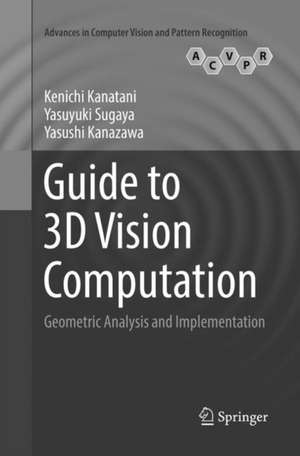Guide to 3D Vision Computation: Geometric Analysis and Implementation: Advances in Computer Vision and Pattern Recognition
Autor Kenichi Kanatani, Yasuyuki Sugaya, Yasushi Kanazawaen Limba Engleză Paperback – 5 iul 2018
Din seria Advances in Computer Vision and Pattern Recognition
- 20%
 Preț: 998.36 lei
Preț: 998.36 lei - 20%
 Preț: 409.78 lei
Preț: 409.78 lei - 20%
 Preț: 654.70 lei
Preț: 654.70 lei - 20%
 Preț: 775.30 lei
Preț: 775.30 lei - 20%
 Preț: 867.13 lei
Preț: 867.13 lei - 20%
 Preț: 241.87 lei
Preț: 241.87 lei - 20%
 Preț: 659.83 lei
Preț: 659.83 lei - 20%
 Preț: 1084.17 lei
Preț: 1084.17 lei - 20%
 Preț: 328.60 lei
Preț: 328.60 lei - 20%
 Preț: 650.08 lei
Preț: 650.08 lei - 20%
 Preț: 644.66 lei
Preț: 644.66 lei - 20%
 Preț: 652.54 lei
Preț: 652.54 lei - 20%
 Preț: 646.80 lei
Preț: 646.80 lei - 20%
 Preț: 993.60 lei
Preț: 993.60 lei - 20%
 Preț: 1174.92 lei
Preț: 1174.92 lei - 20%
 Preț: 646.80 lei
Preț: 646.80 lei - 20%
 Preț: 672.36 lei
Preț: 672.36 lei - 20%
 Preț: 1166.52 lei
Preț: 1166.52 lei - 20%
 Preț: 920.33 lei
Preț: 920.33 lei - 20%
 Preț: 825.78 lei
Preț: 825.78 lei - 20%
 Preț: 666.58 lei
Preț: 666.58 lei - 18%
 Preț: 953.65 lei
Preț: 953.65 lei - 20%
 Preț: 999.35 lei
Preț: 999.35 lei - 20%
 Preț: 655.02 lei
Preț: 655.02 lei - 20%
 Preț: 595.16 lei
Preț: 595.16 lei - 20%
 Preț: 647.61 lei
Preț: 647.61 lei - 20%
 Preț: 658.33 lei
Preț: 658.33 lei - 20%
 Preț: 1649.61 lei
Preț: 1649.61 lei - 20%
 Preț: 991.46 lei
Preț: 991.46 lei - 20%
 Preț: 994.08 lei
Preț: 994.08 lei - 20%
 Preț: 1062.57 lei
Preț: 1062.57 lei - 20%
 Preț: 985.16 lei
Preț: 985.16 lei - 20%
 Preț: 640.35 lei
Preț: 640.35 lei - 20%
 Preț: 656.03 lei
Preț: 656.03 lei - 18%
 Preț: 950.52 lei
Preț: 950.52 lei - 20%
 Preț: 652.41 lei
Preț: 652.41 lei - 20%
 Preț: 644.81 lei
Preț: 644.81 lei - 20%
 Preț: 996.40 lei
Preț: 996.40 lei
Preț: 308.79 lei
Preț vechi: 385.99 lei
-20% Nou
Puncte Express: 463
Preț estimativ în valută:
59.09€ • 61.86$ • 48.89£
59.09€ • 61.86$ • 48.89£
Carte tipărită la comandă
Livrare economică 02-08 aprilie
Preluare comenzi: 021 569.72.76
Specificații
ISBN-13: 9783319839554
ISBN-10: 3319839551
Pagini: 321
Ilustrații: XI, 321 p. 54 illus., 10 illus. in color.
Dimensiuni: 155 x 235 mm
Ediția:Softcover reprint of the original 1st ed. 2016
Editura: Springer International Publishing
Colecția Springer
Seria Advances in Computer Vision and Pattern Recognition
Locul publicării:Cham, Switzerland
ISBN-10: 3319839551
Pagini: 321
Ilustrații: XI, 321 p. 54 illus., 10 illus. in color.
Dimensiuni: 155 x 235 mm
Ediția:Softcover reprint of the original 1st ed. 2016
Editura: Springer International Publishing
Colecția Springer
Seria Advances in Computer Vision and Pattern Recognition
Locul publicării:Cham, Switzerland
Cuprins
Introduction.- Part I: Fundamental Algorithms for Computer Vision.- Ellipse Fitting.- Fundamental Matrix Computation.- Triangulation.- 3D Reconstruction from Two Views.- Homography Computation.- Planar Triangulation.- 3D Reconstruction of a Plane.- Ellipse Analysis and 3D Computation of Circles.- Part II: Multiview 3D Reconstruction.- Multiview Triangulation.- Bundle Adjustment.- Self-calibration of Affine Cameras.- Self-calibration of Perspective Cameras.- Part III: Mathematical Foundation of Geometric Estimation.- Accuracy of Geometric Estimation.- Maximum Likelihood and Geometric Estimation.- Theoretical Accuracy Limit.- Solutions.
Notă biografică
Dr. Kenichi Kanatani is a Professor Emeritus at Okayama University, Japan. Drs. Yasuyuki Sugaya and Yasushi Kanazawa are Associate Professors in the Department of Computer Science and Engineering at Toyohashi University of Technology, Japan.
Textul de pe ultima copertă
This classroom-tested and easy-to-understand textbook/reference describes the state of the art in 3D reconstruction from multiple images, taking into consideration all aspects of programming and implementation. Unlike other textbooks on computer vision, this Guide to 3D Vision Computation takes a unique approach in which the initial focus is on practical application and the procedures necessary to actually build a computer vision system. The theoretical background is then briefly explained afterwards, highlighting how one can quickly and simply obtain the desired result without knowing the derivation of the mathematical detail.
Topics and features:
Topics and features:
- Reviews the fundamental algorithms underlying computer vision, and their implementation
- Describes the latest techniques for 3D reconstruction from multiple images
- Summarizes the mathematical theory behind statistical error analysis for general geometric estimation problems
- Offersexamples of experimental results, enabling the reader to get a feeling of what can be done using each procedure
- Presents derivations and justifications as problems at the end of each chapter, with solutions supplied at the end of the book
- Explains the historical background for each topic in the supplemental notes at the end of each chapter
- Provides additional material at an associated website, include sample code for typical procedures to help readers implement the algorithms described in the book
Caracteristici
Presents state-of-the-art algorithms essential for 3D analysis from images Provides direct algorithm descriptions without mathematical preliminaries Includes helpful implementation details for efficient computation and wise memory use Describes the underlying mathematical theories separately at the end of the volume, and supplies sample codes at an associated website Includes supplementary material: sn.pub/extras
